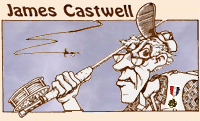|
Neil will remember him. He used to show up at the same
riverside campground we spent our summer weekends at
on the Au Sable river in Michigan. We never did get to know
him although we spent many days and nights in the same small
unimproved recreation area. He was a loner and fished by
himself always. He also had a hobby which probably
consumed him in the end. We referred to him as 'case-a-day'
due to that particular hobby. He was an economist of
anything physical and spent many afternoons relaxing in
a webbed chaise lounge at the campground practicing his
afore mentioned 'recreation'.
I never did fish with him, we hardly ever acknowledged each
other, just was not in the cards. Too much of a clash of life
styles. Neil and I were into studying the insects and not at
all interested in his recreational lifestyle. But, one day at
about noon, as I got all rigged up and was about to start
into the stream at the rivers edge, I saw him wading down
the middle, coming straight at me. My intent was to fish dry,
of course, and he was coming down, swinging wets. The
bad part was that he had a darn nice brown trout on a stringer
tied to his belt.
I did not step into the stream right then but lazed along the
shoreline and waited for him to fish his way on past me. I
then intended to fish my way upstream right over the water
he had just come through. I figured that I could pick the stream
edge pockets and have a nice day of it. But, when I saw that
brown of his, I just had to say something. Something like,
how are you doing, nice fish, whatcha get him on.
The obvious answer, if you haven't guessed it by now, was
a "Fuzzy-Bugger!" Well, just a little like that string on the bulletin
board now about the Adams, what the heck is a Fuzzy-Bugger?
I suppose it is anything you want it to be. Just as some are claiming
that no matter how you tie your fly you can call it an Adams and
be as right as anyone else since there is no definitive authority on
the names which is universally agreed upon.
Myself, I tend to lean toward some accepted consensus of
things. Like the general description of the Adams. If it has a
red body, it is not an Adams. Just my humble opinion of course.
Well, 'case-a-day' gave me one of his flies. Now, how about that.
Here is a guy we have been avoiding for a few years, yes, years,
and he right out and up and gives me a fly. Pretty darned nice
of him.
Right today on the bulletin board here there is a bit of a dust
up about the names of some bits of feather, those little stubbets
at the bottom of some feathers. Filoplumes or aftershaft. They
will get it figured out, I am confident of that. I wonder who they
will use for a reference though. I am not sure who takes credit
for making the absolute decision on it. Probably a long time back,
perhaps from England.
My buddy Neil used to drive me about nuts with his command
of the 'scientific' names of the trout bugs we were trying to learn.
They came easily to him, smart and degree'd and such, but I
only had one year of biology and had a lot to make up for.
"Lumper's and Splitter's," he proclaimed, "They will destroy
the earth." Just about the time most of the scientific community
would agree on the name of an insect, and worse yet, publish
it in some tome, someone else would decide that the bug should
be in some other family or genus or somewhere and give it a
whole new name. Can you just imagine what would happen
if they decided to change a Royal Coachman and tie it with
no wings? A woolly-bugger without any palmering? Cut the
bottom off of a regular hackled fly and call it a 'thorax' tied
pattern? Stuff like that sends chills up my spine. It would jar
the whole fly fishing community. We can consider ourselves
lucky indeed that we do not have any 'lumper's and splitter's'
involved with the exact naming of our flies.
Fortunate that we all agree on how they are tied. 'Fuzzy-Bugger?'
Doesn't matter. Tie it any way you want to. Name it if you like.
Who's to say? ~ James Castwell
|



